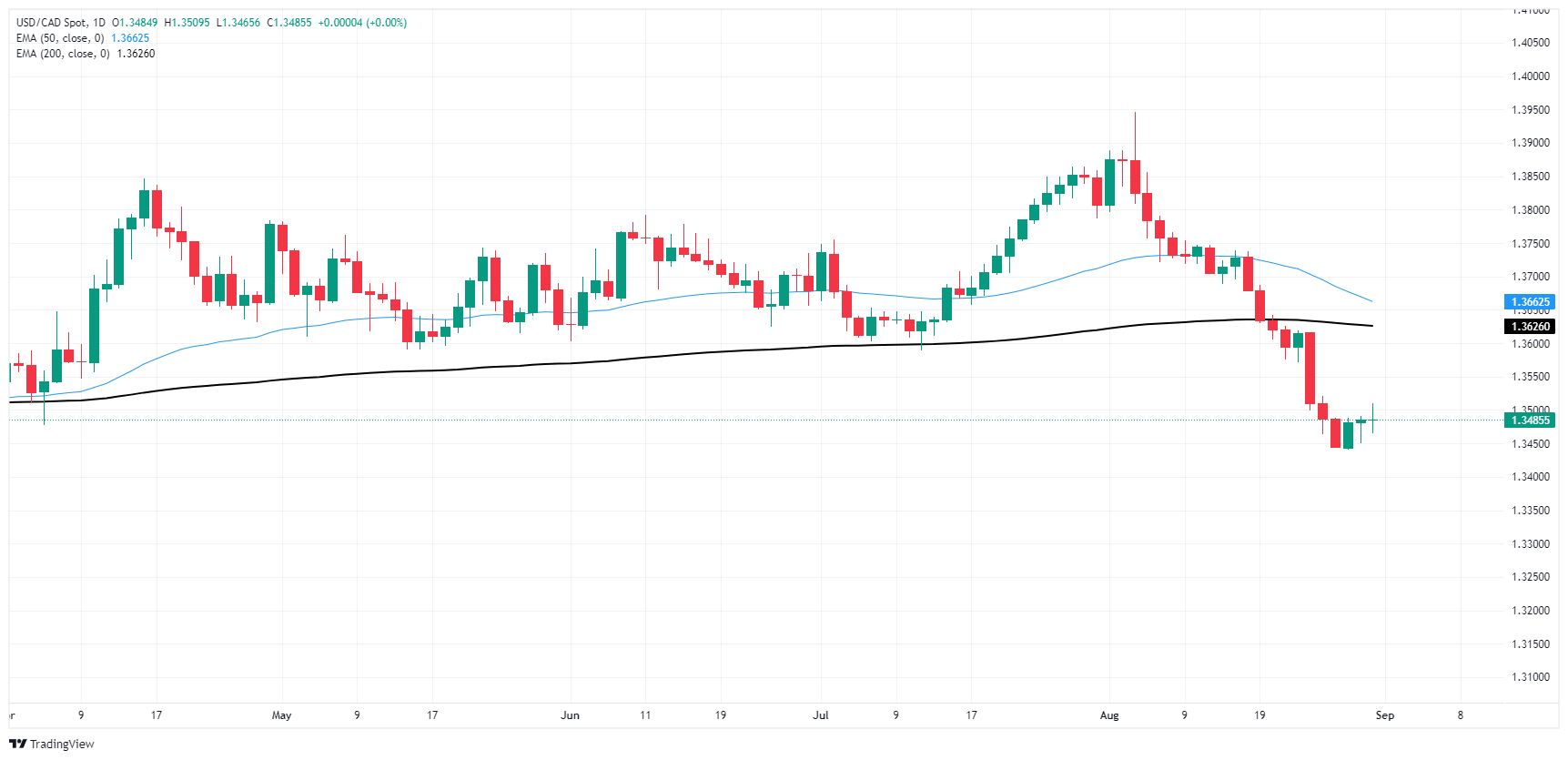- Analytics
- News and Tools
- Market News
- Canadian Dollar fails to spark interest after GDP print
Canadian Dollar fails to spark interest after GDP print
- The Canadian Dollar is on the high side for Friday, but flows remain thin.
- Canada printed a better-than-expected GDP result in Q2.
- Next week brings another BoC rate call, 25 bps cut expected.
The Canadian Dollar (CAD) recovered some slight ground against most of its major currency peers on Friday, but trading remains thin as market flows struggle to find interest in the CAD. The Canadian Dollar also failed to spark a bid against the Greenback, waffling into the low side against the USD after an upside beat in Canadian Gross Domestic Product (GDP) growth failed to generate a meaningful bullish bid.
Canada is set to go dark for a long weekend, leaving next week’s opening volleys an even thinner affair than usual. A looming rate cut from the Bank of Canada (BoC) will also keep CAD flows trimmed thinner than usual.
Daily digest market movers
- Canadian GDP in the second quarter ticked up to 0.5% from the previous 0.4%.
- Annualized Canadian Q2 GDP also jumped to 2.1% from the previous 1.8%, thumping the expected downshift to 1.6%.
- Despite the overall upbeat swing in the print, MoM GDP stumbled, printing at a flat 0.0% compared to the previous 0.2% and missing the median market forecast of 0.1%.
- Global markets are gearing up for a quiet open next week with both CAD and USD markets shuttered for the long weekend.
- The BoC is broadly expected to deliver yet another rate trim of 25 bps next Wednesday, bringing the main reference rate down to 4.25%.
Canadian Dollar price forecast
The Canadian Dollar (CAD) screeched to a halt against the Greenback on Friday, pulling into the day’s midrange and sticking close to the day’s opening bids. A bullish bid beneath the CAD is slowly rolling over from a brief pause into a possible pullback, leaving USD/CAD poised for a rebound back toward the 200-day Exponential Moving Average (EMA).
USD/CAD daily chart
Canadian Dollar FAQs
The key factors driving the Canadian Dollar (CAD) are the level of interest rates set by the Bank of Canada (BoC), the price of Oil, Canada’s largest export, the health of its economy, inflation and the Trade Balance, which is the difference between the value of Canada’s exports versus its imports. Other factors include market sentiment – whether investors are taking on more risky assets (risk-on) or seeking safe-havens (risk-off) – with risk-on being CAD-positive. As its largest trading partner, the health of the US economy is also a key factor influencing the Canadian Dollar.
The Bank of Canada (BoC) has a significant influence on the Canadian Dollar by setting the level of interest rates that banks can lend to one another. This influences the level of interest rates for everyone. The main goal of the BoC is to maintain inflation at 1-3% by adjusting interest rates up or down. Relatively higher interest rates tend to be positive for the CAD. The Bank of Canada can also use quantitative easing and tightening to influence credit conditions, with the former CAD-negative and the latter CAD-positive.
The price of Oil is a key factor impacting the value of the Canadian Dollar. Petroleum is Canada’s biggest export, so Oil price tends to have an immediate impact on the CAD value. Generally, if Oil price rises CAD also goes up, as aggregate demand for the currency increases. The opposite is the case if the price of Oil falls. Higher Oil prices also tend to result in a greater likelihood of a positive Trade Balance, which is also supportive of the CAD.
While inflation had always traditionally been thought of as a negative factor for a currency since it lowers the value of money, the opposite has actually been the case in modern times with the relaxation of cross-border capital controls. Higher inflation tends to lead central banks to put up interest rates which attracts more capital inflows from global investors seeking a lucrative place to keep their money. This increases demand for the local currency, which in Canada’s case is the Canadian Dollar.
Macroeconomic data releases gauge the health of the economy and can have an impact on the Canadian Dollar. Indicators such as GDP, Manufacturing and Services PMIs, employment, and consumer sentiment surveys can all influence the direction of the CAD. A strong economy is good for the Canadian Dollar. Not only does it attract more foreign investment but it may encourage the Bank of Canada to put up interest rates, leading to a stronger currency. If economic data is weak, however, the CAD is likely to fall.
© 2000-2025. All rights reserved.
This site is managed by Teletrade D.J. LLC 2351 LLC 2022 (Euro House, Richmond Hill Road, Kingstown, VC0100, St. Vincent and the Grenadines).
The information on this website is for informational purposes only and does not constitute any investment advice.
The company does not serve or provide services to customers who are residents of the US, Canada, Iran, The Democratic People's Republic of Korea, Yemen and FATF blacklisted countries.
Making transactions on financial markets with marginal financial instruments opens up wide possibilities and allows investors who are willing to take risks to earn high profits, carrying a potentially high risk of losses at the same time. Therefore you should responsibly approach the issue of choosing the appropriate investment strategy, taking the available resources into account, before starting trading.
Use of the information: full or partial use of materials from this website must always be referenced to TeleTrade as the source of information. Use of the materials on the Internet must be accompanied by a hyperlink to teletrade.org. Automatic import of materials and information from this website is prohibited.
Please contact our PR department if you have any questions or need assistance at pr@teletrade.global.















